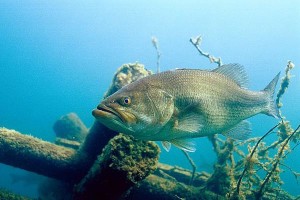Understanding the biology of the eye of the fish is very often not even talked about, yet is very important to being able to catch a lot of bass.
Bass are often called sight predators—so it only makes sense for us to gain at least an elementary understanding of the way they do this. That’s what we will be looking at in depth today.
Don’t worry, this won’t be a biology class, but it will give you a basic understanding of the biology of the eye of the fish, so that you can more effectively catch them.
The Eye Of The Bass
To understand the eye of the bass, we need to understand just a bit about the brain of the fish as well.
The ocular lobe of the brain on a bass is huge, relatively speaking1. So, to make that just a bit simpler, we can conclude that an inordinate amount of a bass’s brain power is dedicated to the sense of sight. If that doesn’t convince you just how important site is to the fish, then nothing will!
Since we know that a ton of resources are committed to the sense of sight, then it makes sense for us now to move on to looking at just what it is they see when they are looking at your baits.
The Structure of the Eye
 Bass have a bulbous, protruding eye, which allows them a much larger field of vision than you or I have.
Bass have a bulbous, protruding eye, which allows them a much larger field of vision than you or I have.
You don’t need to be a biologist to understand this—I think we have all seen bass swim off in a hurry when we approached them, even though we approached from behind. They do have just a few blind spots however, and those are directly below, and directly behind them.
Their sight is what is referred to as “monocular,” as opposed to binocular.
Essentially, this means that to get the best view of any given object, both eyes must see it. The fish will be able to detect motion on both sides of them very easily, but won’t completely understand what that motion is until they are in a position to have both eyes focused on the object.
Now, let’s answer the biggest question of them all…
Do Bass See Color?
Really, the question here is are all of those many different colors in your tackle box worth having at all?
Unequivocally, the answer is yes. Bass do indeed see color. They possess both cones and rods in their eye, and it is the cones that allow creatures to see colors.
The exact amount, and exact kind of cones is uncertain right now, but their presence is proof that they see color in some capacity.
Being able to see color is in direct relation to light conditions. The clearer the water, and the brighter the light, the more the blue end of the color spectrum will be easily visible, and the red end will be less so1.
There has been some evidence that bass see red better than any of the other colors in the spectrum2.
At night, things change a bit.
How Do Bass See At Night?
So, the sun is going down and it’s getting darker, how does this affect the vision of the fish?
Actually, it’s just like our vision—when it gets dark, our cones play a reduced role, and our cones take over to display contrast, motion, and shadows.
Bass are the same way. When the sun goes down, you will want to play with more contrast than actual color variation (we have an article coming soon that will go into detail on specific strategies for this, so stay tuned).
Conclusion
Getting a general idea of the way bass see will help make you a better bass fisherman.
Here are the main points to remember:
- Bass see color (red probably best)
- Their sight is monocular
- At night, it’s all about contrast
See ya on the water…
References
1. http://www.bassmaster.com/news/biologists-look-bass-senses
2. http://sportsillustrated.cnn.com/vault/article/magazine/MAG1076448/index.htm